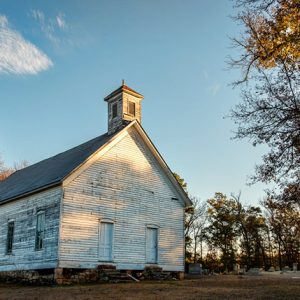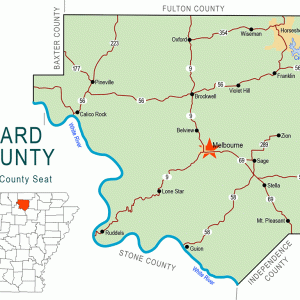calsfoundation@cals.org
Forty-Four (Izard County)
Forty-Four (sometimes spelled without the hyphen) in Union Township of Izard County is a historic community on Highway 56 about five miles northeast of Calico Rock (Izard County). The Forty-Four post office opened in 1928 and served the rural area until 1979. The story goes that forty-four names appeared on the petition to the postal department, thus the name.
The region served as a hunting ground for the Osage and, later, the Cherokee and Shawnee. The first white settlers appeared around 1828 when a new treaty ended the Cherokee Reservation in Arkansas. The Benge route of the Trail of Tears passed a few miles west of Forty-Four.
The Old Benbrook Mill on Piney Creek was near the site of what would become Forty-Four and about four miles east of Calico Rock. In his book Life in the Leatherwoods, John Quincy Wolf related: “It ground both wheat and corn and had a large carding factory adjacent to it. It was the only mill within a large scope of the country and naturally enjoyed a large patronage, its clientele extending across White River into what is now Stone County.” The mill was operated by Elbert Benbrook and was built before the Civil War. The mill shut down around 1880.
During the lawless days of the early post-Reconstruction period, A. J. Hamilton and John Hare were ambushed near Lunenburg (Izard County) in the spring of 1878, during which Hamilton was fatally shot. A man from the Spring Creek area, James Henry Staggs, was convicted of the murder and sentenced to prison in Little Rock (Pulaski County). Hamilton and Hare had testified against Staggs the year before in a trial involving a shooting during a land dispute. Staggs escaped from prison, fled west, and started a new family. He took the alias Robert Henry Benbrook, believed to be derived from the name of his father’s deceased friend, a brother to Elbert Benbrook. Staggs is buried under that name, and the name was still used by his new family.
The earliest school in the area was an academy established late in the 1870s at Spring Creek, about three miles east of Calico Rock, and was known as the Spring Creek Academy. J. A. Kerr, a highly respected educator, taught there. Following the closing of the academy, the children of the sawmill workers and others who lived in Forty-Four attended the Flat Rock School. Today, the entire area is part of the Calico Rock School District.
Historic Flat Rock Methodist Church is located just off Highway 56 on County Road 234 about three miles east-northeast from Forty-Four. Built in 1873, it stands near the banks of Flat Rock Creek. The Flat Rock Cemetery is next to it. Its first trustees were Absolom Langston, Perry Benbrook, John W. Franks, John Arnold, Levi Byram, and Jacob P. Franks. The original structure was built of native logs. At one time, the Flat Rock School was located near the church, but the building no longer stands.
The sawmill industry first came to the area in the 1880s and, by the turn of the century, had become a boon to the local economy. By 1900, a large sawmill was operating on the Forty-Four spot, and a community grew up around it, where many of the workers lived. The lumber company had several buildings with sundry building materials. A post office at Benbrook Mills served the residents before the Forty-Four post office was established in 1928, with John W. Key the first postmaster. The store/post office was run by Coy Richardson in the 1930s and by Lonnie and Jewel Blankenship from 1951 until the post office closed in 1979. A store on Piney Creek, about a half mile east of the post office, was run by the Webb family; the store building, which became a private residence, still stands.
Not much remains of the once vibrant timber community of Forty-Four. The Washington family has a well-drilling and repair facility at the site of the old mill. The lumber dryer is still visible in Forty-Four, and the old sawmill is standing but no longer runs. The large building where the company displayed its building materials and sold to the public is also standing. The Arkansas Department of Transportation has a Forty-Four road sign at Piney Creek, a few miles from historic Forty-Four, and one at the Wideman Road.
For additional information:
Blevins, Brooks. Hill Folks: A History of Arkansas Ozarkers and Their Image. Chapel Hill: University of North Carolina Press, 2002.
Jeffery, Augustus Curren. Historical and Biographical Sketches of Early Settlement of the Valley of the White River Valley Together with a History of Izard County. Richmond, VA: Jeffery Historical Society, 1973.
Wolfe, John Quincy. Life in the Leatherwoods. Memphis: Memphis State University Press, 1974.
Kenneth Rorie
Van Buren, Arkansas
 Flat Rock Methodist Church
Flat Rock Methodist Church  Izard County Map
Izard County Map 




When I was ten, in 1957-58, my family moved to Forty-Four. I’m so happy to find a bit of history about it. I boarded the school bus at the Post Office named here. The school, even then, was old and in poor repair. Luck did not serve us well. My father, skilled in many trades, could not find a job. The house we had bought burned down from electrical issues, and we ended up moving to Missouri. However, two years of childhood memories were made in Forty-Four.